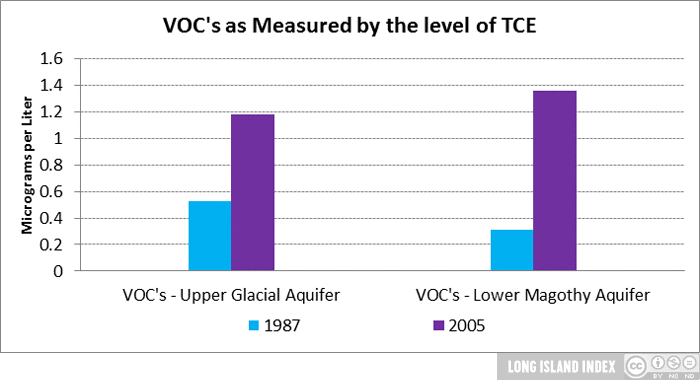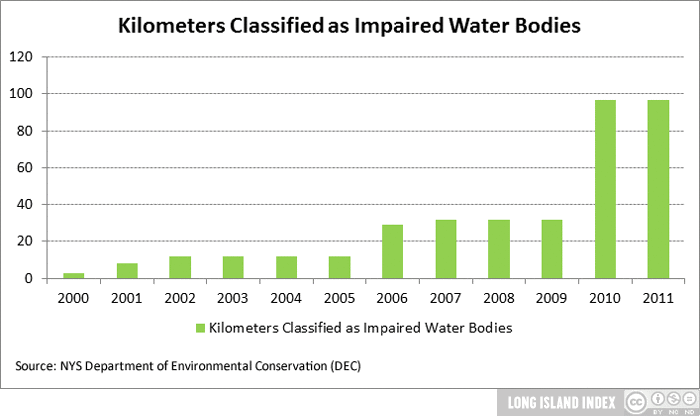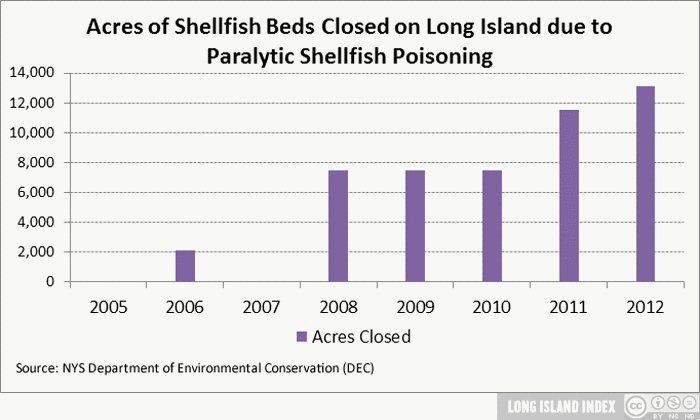Long Island is experiencing a rapid rise in contaminants in our aquifer system and in our surface waters.
Why is this important?
The aquifer system that lies beneath Long Island is the sole source of drinking water for the region’s 2.85 million residents. The quality and quantity of the water contained in the aquifer system is directly impacted by the way we use and treat the land above it. Should parts of the aquifer system become depleted or contaminated, the Island will be faced with the higher costs associated with increased treatment and infrastructure investments. Among the contamination threats facing the aquifer system are: Volatile Organic Compounds (VOC’s) -which are found in household cleaning supplies and other industrial uses – and Pesticides, which are commonly used on our lawns and gardens and by the Island’s agricultural community.
How are we doing?
Ground Waters
In 2011, Suffolk County released a report documenting the changes in the quality of water underlying the county between 1987 and 2005, the two years comprehensive examinations of the aquifer system were undertaken. Similar data does not exist for Nassau County.
Nitrates are dangerous to humans at levels of 10 milligrams per liter (mg/l), but can have severe impacts on aquatic ecosystems at levels as low as 2 mg/l. Between 1987 and 2005, the level of nitrates in the upper portion of the aquifer system (Upper Glacial) increased 39% to 4.34 mg/l from 3.12mg/l. In a lower section of the aquifer (Lower Magothy), nitrate levels increased 193% to 3.34 mg/l from 1.14 mg/l over the same period of time. If unabated, nitrate levels in the Upper Glacial aquifer will surpass the 10 mg/l threshold within the next 40 years.
Although safe drinking water standards have been established for most individual volatile organic compounds (VOC’s), sufficient research has not been conducted examining the impacts of exposure to multiple VOC’s over time. Levels of TCE, a volatile organic compound most commonly used by dry cleaners, were documented as part of Suffolk County’s study. Between 1987 and 2005, the level of TCE in the Upper Glacial aquifer increased 123% to 1.18 from 0.53 micrograms per liter (m g/l). Levels in the Lower Magothy aquifer increased 339% to 1.36 m g/l from 0.31.
Suffolk County’s study also documented how many different pesticides were detected in tests of the county’s 220+ public wells. In 1987, tests revealed 8 different pesticide related compounds. By 2005, the number of pesticide related compounds had increased over 900% as more than 80 different pesticide related compounds were detected.
Surface Waters
Long Island’s surface waters have been severely degraded due to our inability to address pollution caused by sewage, septic systems, cesspools and runoff. If these issues are not corrected, the impacts on the Island’s fishing and tourism industries and general quality of life could be significant.
Sewage, septic systems, cesspools and runoff all carry nitrates into Long Island’s streams and bays. As nitrate levels in these water bodies increase, the natural ecosystem’s ability to filter the contaminants can be overwhelmed. When this happens, harmful algal blooms can appear leading to further degradation.
Due to algal blooms and other water quality problems, Long Island has seen an increase in the amount of water bodies deemed “Impaired” by the NYS Department of Environmental Conservation (DEC) in recent years. In 2000, approximately 3 kilometers of the Island’s southern bays were classified as “Impaired Water Bodies”. By 2011, 97 kilometers were classified as “Impaired Water Bodies” by the DEC, encompassing nearly the entire South Shore Estuary and equating to roughly ¼ of the Island’s total coastline.
Some algal blooms cause paralytic shellfish poisoning (PSP), which makes certain shellfish toxic for consumption. Prior to 2006, Long Island had never experienced an instance of PSP in its coastal waters. Since that time, PSP has been detected Northport Harbor, Huntington Harbor, Shinnecock Bay, Mattituck Inlet and Sag Harbor Cove. In 2012, over 13,000 acres of shellfish beds were closed due to paralytic shellfish poisoning.


